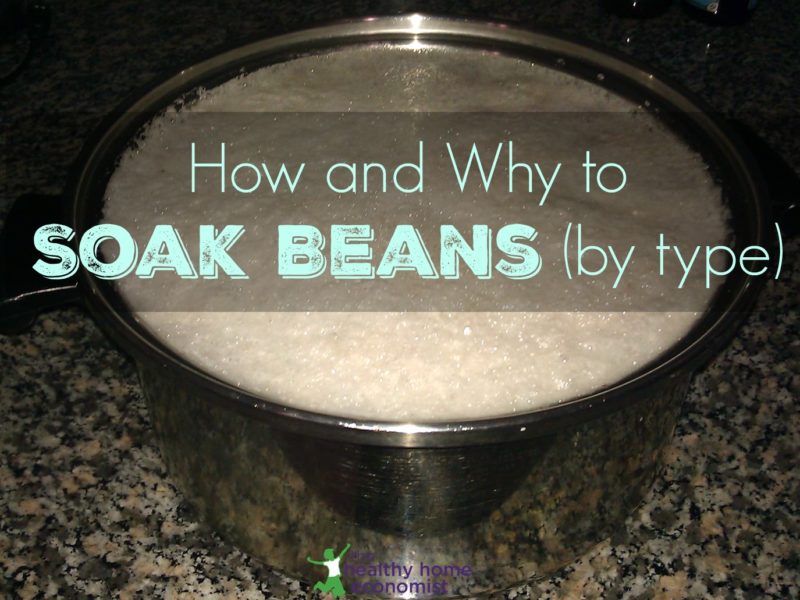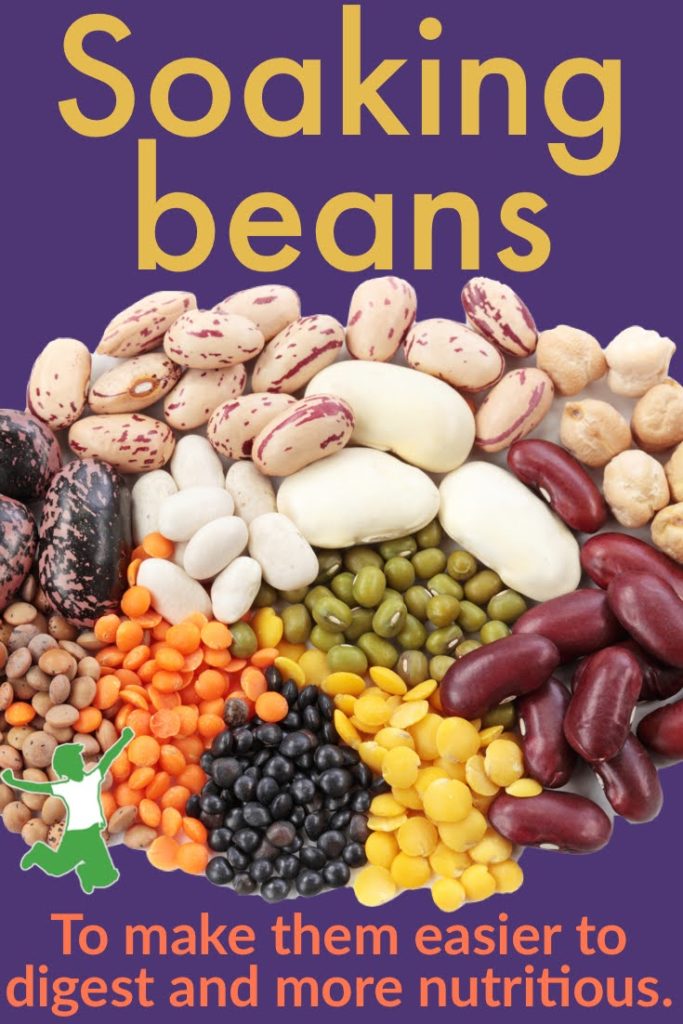Table of Contents[Hide][Show]
The simple overnight process of how to soak beans (by type) will help to eliminate gas and intestinal issues so you can enjoy eating these nutritious plant foods again!

I went on a bean soaking binge this past weekend, and the amount of scum that came to the top of the large pot of soaking kidney beans was so huge, I thought it deserved its own blog post. Soaking beans for many hours before cooking them produces a lot of scum which is course, is rinsed and drained away when the soaking is complete.
What is all that scum anyway? Anti-nutrients, that’s what! And those anti-nutrients such as phytic acid, lectins, and enzyme inhibitors are going to be in your gut causing you gas, heartburn, reflux, and whatever other digestive ills beset you when you eat something that isn’t particularly digestible unless you soak your beans before cooking them.
Traditional cultures took great care to prepare their legumes with a long soak before cooking to enhance digestibility and nutrient absorption.
I love Mexican food but really try to avoid Mexican restaurants for this reason .. they don’t soak their beans before cooking them!
After a meal at a Mexican restaurant, I will typically feel very bloated. Eating the same meal prepared at home where I soaked the beans properly before cooking results in no digestive upset whatsoever.
Take the Soaked Beans Challenge!
If you think unsoaked beans don’t cause you any trouble .. take this challenge. Soak beans next time before cooking and notice the difference in your stomach after eating.
You may think that the unsoaked beans don’t cause you any trouble, but you just may find that soaked beans are infinitely more filling and that you eat less and enjoy the meal more as a result!
Traditional peoples were very wise in the preparation of their foods. They not only selected nutritious foods but they prepared them for maximum digestibility and nutrition.
What good is eating nutritious legumes if the body is so whacked by the anti-nutrients that it can’t very easily extract and digest the nutrition?
So, the next time you make your beans, make sure you soak them first!
I soak large pots of various types of beans every month or so and then cook them – freezing for easy, quick meals when beans are required like homemade chili.
**If you absolutely do not have time to do this, at least buy pre-soaked legumes and beans packed in glass jars. Your digestion will thank you!
How To Prepare Beans by Soaking (video tutorial)
If you’ve never soaked beans before, it’s so easy. It’s a very similar process to soaking nuts. The method also mimics the wisdom of traditional societies that soaked seeds.
See this short video below that demonstrates the simple process.
Kidney shaped beans
For kidney shaped beans and dried/split peas, put a pinch of baking soda and enough water to cover in a large pot and soak uncovered for 12-24 hours. Drain, rinse and cook as usual.
Examples of kidney-shaped beans include:
- Red kidney beans
- White kidney beans (cannellini beans)
- Pinto beans
- Anasazi beans
- Black-eyed beans (black-eyed peas)
- Great Northern beans
- Lima beans
Non-kidney shaped beans (and other legumes)
For more oval-shaped beans and other legumes, soak for 12-24 hours in filtered water to cover plus 1 tablespoon of cider vinegar or lemon juice for every cup of dried beans/legumes used.
A homemade apple cider vinegar recipe or store-bought are both fine (make sure the ACV is packed in glass). Liquid whey from yogurt, kefir, or clabbered milk may also be used. Drain, rinse, and cook as usual.
Examples of non-kidney shaped beans include:
- Black beans (turtle beans)
- Navy beans
- Fava beans
- Adzuki beans
- Chickpeas
- Lentils
For maximum digestibility, it is best to rinse and refresh the filtered water and baking soda or the acidic medium once or twice during the soaking period. If you forget, no worries.
I try to always soak beans for the full 24 hours instead of just overnight. Sometimes if I get busy, I might even soak them 36 hours, but this is risky as they can get moldy sometimes if you go over 24 hours. Best to stay between 12-24 hours particularly during summer months.
How to Cook Beans After Soaking
After soaking, be sure to thoroughly drain and rinse the beans until all the scum is washed away. Then, complete the process by doing the following.
- Fill the pot of rinsed pre-soaked beans with fresh filtered water, bring to a boil, and skim away any additional foam that may come to the top at the start of the boil.
- Turn down the heat to a simmer, add 4 crushed garlic cloves, and cook until the beans are soft (about 4 hours).
- Drain beans and add to your favorite dish or let cool and freeze in large freezer bags for quick meals at a later date!
You won’t be needing over-the-counter gas meds after preparing beans the traditional way!
Should You Use the Soaking or Cooking Water?
Some alternative cooking circles advocate using the soaking or bean cooking water. Unfortunately, neither of these practices is traditional.
Using the cooked bean water or aquafaba is actually a dangerous practice. See the linked article for reasons to avoid this modern food especially during pregnancy!
Other Types of Legumes
This article plus video on soaking lentils provide additional information specifically for this legume. Because they are soaked exactly the same as all non-kidney shaped beans, it is helpful for visual learners.
Lentils were the favorite of nutritional pioneer Dr. Weston A. Price due to their very high potassium content.
Recipes Using Pre-soaked Beans and Legumes
Here are some recipes to try using soaked beans and other legumes to entice you!









Hi. I was reading that soaking beans is better to do; before cooking; Also,
By mistake I started Cooking Lentils in Broth and Coconut Water Before Soaking them. Also I had added spices, and garlic and onion, and a bay leaf. Then, I read about Soaking . So I rinsed
them under warm Water and left them in the warm water to soak overnight.
However, they were cooking in the pot for an hour. Is this going to affect the Gas problem ?
Since I took them off the Stove, and am Now Soaking them, Overnight. I was also going to Plan to Cook them Up again in the Slow cooker after the Soaking Process.
Also, Can I still use the Broth / Coconut Water Mixture ? As I had saved this. Or is this affected by
Problems as far as boiling it with unsoaked unwashed lentils. ?
Thanks for any experience with this Situation.
I have been cooking beans, after soaking, for years and have never seen that ‘scum’ before. Are you using organic beans? I also wonder if what you are seeing is a product of bacterial growth from the liquid whey- similar, but not quite the same- as the natural fermentation process of probiotics.
Yes, I always use organic beans.
Same here Danielle; I’ve never seen that huge topping of “scum” and I’ve cooked beans after soaking all my life — the only way I know. The photo looks kind of like when adding baking soda.
Same here also, I have never seen this “scum” after soaking my beans. Beans don’t have this huge amount of antinutrients and they don’t require extended soaking. Generations of bean eaters have been reaping the benefits of beans with minimal processing for centuries. And within the last, at least 50 years, you can use a pressure cooker to have your beans flavorful and ready in 15 minutes, no need to cook for 4 hours!
I visited several blogs however the audio quality for audio songs existing at this web page is genuinely fabulous.
Greetings from Carolina! I’m bored at work so I decided to browse your website on my iphone
during lunch break. I enjoy the information you provide here and can’t wait to
take a look when I get home. I’m amazed at how fast your blog loaded on my mobile ..
I’m not even using WIFI, just 3G .. Anyhow, great blog!
Hello there! I could have sworn I’ve been to this site before but after reading through some of the
post I realized it’s new to me. Nonetheless, I’m definitely delighted I found it
and I’ll be book-marking and checking back frequently!